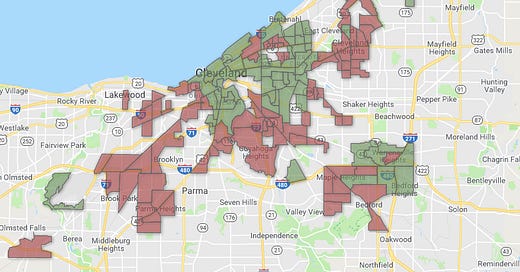So Much Opportunity
For awhile, I just thought people were talking about the Opportunity Corridor, so I skipped over the tweets about Opportunity Zones. Then I scrolled back: zones, huh? It’s the Land (of), I guess!
Opportunity Zones provide tax break incentives for investments in businesses that lie in distressed areas of American cities. Exciting, I thought at first: my business has not one but two offices in distressed areas of Cleveland, which is a city! Dozens of such zones were so designated here. I hurriedly called up the map (green zones are the winners; red zones were nominated but not accepted.)

Well damn. Both of my offices are losers, as they lie approximately 100 yards outside zones. And it is not just a case of rotten luck: only 41 percent of the poorest tracts in Ohio made the cut, and many that did are in hotter areas, like Tremont.
Why didn’t most of the poorest areas quality? Because there is no investment there already. Confusing, right? But this is a tax break for the already-winning: there must be economic growth in a ‘distressed’ area for it to be eligible for tax breaks meant to…promote economic growth. The logic, if we could call it that, is that you need some momentum to assure success. Or, as Wendy Patton of PolicyMatters puts it: “It looks to me as if the winners from this are going to be wealthy investors, opportunity zone fund administrators and attorneys and dealbrokers.”
The first beneficiaries of Opportunity Zones I have found are the developers of The Tappan in Tremont. Sustainable Community Associates are including what they have coined “workforce housing” in this apartment building. “Workforce” is not the same as the more technical terms affordable or low-income housing, but a sui generis one to describe the middle-class. They will rent forty percent of the units in The Tappan for whatever rate they can command; the remaining sixty percent will be rented only to those making less than $46,000/year. In those studios and one bedrooms, rent will range from $1000-1200 per month.
That rent is still higher than the average for city, which is $738-$937. It is also above or about the average rent for a one-bedroom in Tremont, which is $1250.
Now remember: this is a city where 45% of the value of properties are tax-exempt, and another 15% or so are tax abated. Does “Buy Local!”—the movement to keep as many dollars as possible within one’s town — have the same political and economic resonance when the businesses or organizations pays fewer or no taxes?
I bet John Owens and Adam Zagger pay taxes on their Tremont business, Rook Modern. I often brag that Cleveland has the best Goodwills and thrift shops in the nation, and that trickles up to having some of the best vintage and resale shops as well. Rook Modern has a carefully curated collection of gorgeous midcentury modern furniture and decor. I have been stopping in regularly over the past year, since I moved nearby, and last week I finally pulled the trigger, buying two small pieces, including this reasonably-priced Florence Knoll cabinet.

John and Adam drove my new furniture to my apartment and carefully carried them to their new spots, where they now hold my books and blankets. (NB: they also ship.) It felt good to give them my money.

